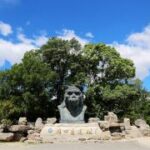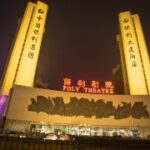Guozijian Street is located in Dongcheng District, Beijing. It starts from Yonghegong Street in the east and ends at Andingmennei Street in the west. It is a well-known archway street in Beijing, also known as ‘Chengxian Street’. Guozijian Street is an old street of Dadu in the Yuan Dynasty. At that time, the Imperial College was located here. During the Ming and Qing Dynasties, it was the Confucius Temple (No.
13) and the Imperial College (No. 15), with a history of more than 700 years. The entire ancient street is 680 meters long and 12 meters wide. There are four archways on the street. The archways at the east and west ends of the street are street archways, titled ‘Chengxian Street’. There are two other archways on both sides of the gate of the Imperial College, titled ‘Imperial College’, to show respect for the important national institution. On both sides of the east and west of the archway, there are dismounting stone tablets. On them are carved in six languages including Manchu, Han, Mongolian, Tibetan, Hui, and Torgut: ‘Officials and others, dismount here’. Emperor Qianlong praised it as ‘Beijing is the leading benevolent area, and the Imperial College is the leading benevolent place’. In addition to archways, the Imperial College, and the Confucius Temple on this street, there are also many cultural relics and historic sites. Opposite the gate of the Imperial College on the south side of the street is a screen wall. No. 40 Guozijian Street on the south side of the road was once the Kitchen God Temple, and No. 78 Guozijian Street was once the Fire God Temple. The Kitchen God Temple has been demolished. The existing Fire God Temple has a gate, main hall, main hall and east-west side halls, worshipping the Fire God, Guan Yu, Lu Ban, etc. Courtyard No. 3 of the Imperial College is the Songtang Museum, a private museum displaying door piers, ancient statues, ancient building decorative components, and various wood carvings and stone carvings. Most of the residences on both sides of the ancient street are low, neat quadrangles with gray walls and gray tiles, preserving the style and features of old Beijing alleys. The locust trees on both sides are lined up. The green crown and thick shade are in harmony with the four painted archways, large and small courtyards, and temples, creating a quiet and peaceful atmosphere, making the entire Guozijian Street full of antique charm. The specific opening hours and business status are subject to the opening situation on that day.Guozijian Street
Guozijian Street is located in Dongcheng District, Beijing. It starts from Yonghegong Street in the [...]









